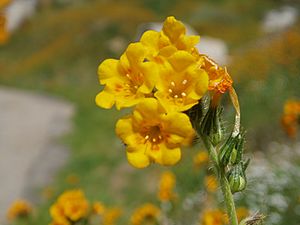Fiddleneck facts for kids
Quick facts for kids Fiddleneck |
|
|---|---|
 |
|
| Amsinckia eastwoodiae | |
| Scientific classification |
|
| Kingdom: | Plantae |
| Clade: | Tracheophytes |
| Clade: | Angiosperms |
| Clade: | Eudicots |
| Clade: | Asterids |
| Order: | Boraginales |
| Family: | Boraginaceae |
| Subfamily: | Boraginoideae |
| Genus: | Amsinckia Lehm. |
| Type species | |
| Amsinckia lycopsoides |
|
| Species | |
|
Amsinckia calycina |
|

Fiddlenecks are a group of flowering plants. They are also known by their scientific name, Amsinckia. These plants get their common name because their flower stems curl over at the top. This shape looks a lot like the head of a fiddle, a musical instrument.
Fiddlenecks belong to the plant family called Boraginaceae. Other plants in this family include borage and forget-me-nots. The name Amsinckia was given to honor Wilhelm Amsinck. He was a important person from Hamburg, Germany, who supported the study of plants.
Contents
Where Do Fiddlenecks Grow?
Fiddlenecks are originally from western North America and southwestern South America. However, they have spread and now grow in many other parts of the world. These plants are annuals, which means they complete their entire life cycle in one year.
Most fiddlenecks have stems that stand straight up. These stems can grow from about 20 to 120 centimeters tall. Most of their flowers are yellow, sometimes with a hint of orange. You usually find fiddlenecks in lower areas, below 500 meters in height.
Are Fiddlenecks Safe?
The seeds and leaves of fiddleneck plants can be harmful to farm livestock. This is especially true for cattle. The plants contain natural chemicals called alkaloids and high levels of nitrates, which can make animals sick.
The sharp hairs on fiddleneck plants can also irritate human skin. However, some Native American groups used parts of the plant as food. They ate the shoots, seeds, or leaves of certain species. Fiddlenecks also had some traditional medicinal uses.
How to Identify Fiddleneck Species
It can be tricky to tell different types of fiddlenecks apart. Many species look very similar, and their natural growing areas often overlap. Also, some species have many slightly different forms. They can even mix naturally to create new types.
Because of this, figuring out exactly which species a fiddleneck plant belongs to often requires a close look. You might need a special identification key to help you identify it correctly.
Common Fiddleneck Species
Here are some of the known species of fiddleneck plants:
- Amsinckia calycina: Also called Hairy fiddleneck or yellow burweed. It grows in Argentina and Chile.
- Amsinckia carinata: Known as Malheur fiddleneck. This plant is rare and only found in Oregon. It is listed as endangered in that state.
- Amsinckia douglasiana: Called Douglas' fiddleneck. It is uncommon and grows in parts of California.
- Amsinckia eastwoodiae: Eastwood's fiddleneck. Found in central and southern California, west of the Sierra Nevadas.
- Amsinckia grandiflora: Large-flowered fiddleneck. This species is found only in the Central Valley of California. It is an endemic plant, meaning it grows nowhere else naturally. Both California and the US federal government list it as endangered.
- Amsinckia lunaris: Bent-flowered fiddleneck. This uncommon plant grows in the San Francisco Bay Area and other parts of California. It is also endemic to California and considered fairly endangered.
- Amsinckia lycopsoides: Tarweed fiddleneck. This is a common type. It grows in all the Pacific coast states of the USA, including Idaho and British Columbia.
- Amsinckia marginata: This species is found only in Ecuador.
- Amsinckia menziesii: Rancher's fireweed. This is a very common fiddleneck. It grows throughout the western USA, British Columbia, and Baja California. It can be found at heights up to 1700 meters. It is also native to South America and has spread to other parts of the world.
- Amsinckia spectabilis: Seaside fiddleneck or woolly breeches. Found along the Pacific coast from British Columbia to Baja California, and on islands nearby. It grows at heights up to 300 meters.
- Amsinckia tessellata: Devil's lettuce or bristly fiddleneck. This is a common species. It grows at heights up to 2200 meters in most of California, Arizona, Oregon, and Washington. It is also found in South America.
- Amsinckia vernicosa: Green fiddleneck. This plant is uncommon. It grows in parts of California, including the south Coast Ranges and the Mojave Desert, up to 1500 meters high.
See also
In Spanish: Amsinckia para niños

